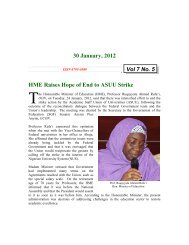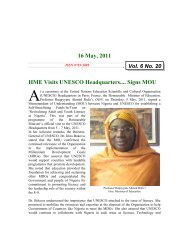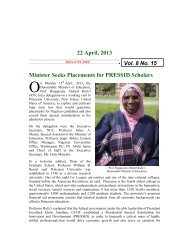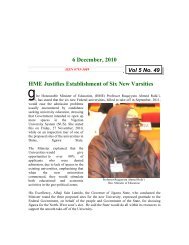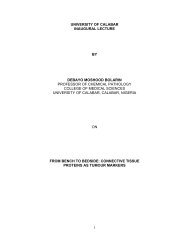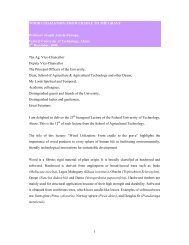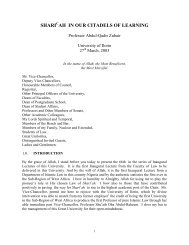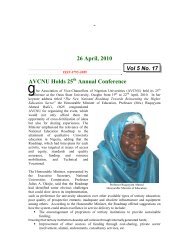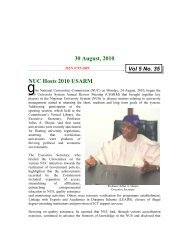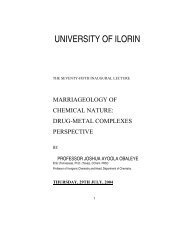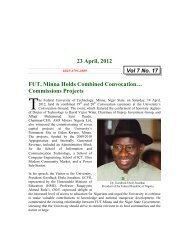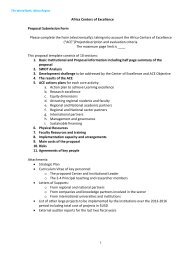relevant micro-concepts of common nigerian civil engineering
relevant micro-concepts of common nigerian civil engineering
relevant micro-concepts of common nigerian civil engineering
Create successful ePaper yourself
Turn your PDF publications into a flip-book with our unique Google optimized e-Paper software.
RELEVANT MICRO-CONCEPTS OF COMMON NIGERIAN CIVIL ENGINEERINGMATERIALSPr<strong>of</strong>essor Danladi Slim MatawalAbubakar Tafawa Balewa University Bauchi5 th November, 2001ABSTRACTOf all the disciples <strong>of</strong> <strong>engineering</strong>, the greatest strides, and the most independent practice inNigeria, has been in the branch <strong>of</strong> Civil Engineering. This is because windfall pr<strong>of</strong>its andincomes <strong>of</strong> oil revenue, since the middle sixties, resulted in huge developmental projects/effortsto provide basic, essential and service infrastructure, <strong>of</strong>fice and housing accommodation for thepopulation and for their desire to improve. This has led, up to date, to completed and ongoingconstruction <strong>of</strong> over 5,000 kilometres expressways, 12,000-15,000 kilometres <strong>of</strong> cross countryfreeways as well as a large volume <strong>of</strong> urban roads and infrastructure. Additionally, there are 7major bridges across the rivers Niger and Benue, not less than 80 bridges on their tributaries andup to 20 bridges across the distributaries on the Niger-delta. Major bridges like the third axial,Mainland and Eko are in Lagos, similar ones in Warri (e.g. the link across the creek from NNPCto Aladja Steel complex), Sapele, Port Harcourt and Calabar in the creeks <strong>of</strong>f the Atlantic oceanhave been built while major seaports and airports, huge buildings, drainages, housing estates,dams, water plants and even a new Federal Capital city <strong>of</strong> Abuja as well as many state and LGcapitals have sprung up. A thriving and vibrant private sector together with frequent shortlivedrise in the living standards <strong>of</strong> the populace has also resulted in private corporate and individualinvestment in housing and <strong>of</strong>fice buildings. All the activities have involved constructionutilizing many <strong>civil</strong> <strong>engineering</strong> materials.The <strong>civil</strong> <strong>engineering</strong> materials that have been most <strong>common</strong>ly used for these activities are soils,stone aggregates, cement, structural steelwork and reinforcement rods, asphalt and timber/woodas well as water. The ubiquitous use <strong>of</strong> these materials has imparted upon the generality <strong>of</strong>Nigerian developers the technical know-how, skills and confidence to apply them frequentlywithout the need for references. It has also led to a complacent attitude as to the utilization <strong>of</strong>1
these materials, which are frequently applied, with many avoidable misapplications resulting inuneconomical, shoddy, cracked, failing and collapsed structures and infrastructure for both theindividual/private as well as the corporate developers. Many <strong>micro</strong> <strong>concepts</strong>; <strong>relevant</strong> andsignificant, have been ignored that could improve the quality <strong>of</strong> our developments, if known andapplied. These <strong>relevant</strong> <strong>micro</strong> <strong>concepts</strong> <strong>of</strong> in-situ materials used in foundations, concrete worksas well as those <strong>of</strong> water applied everywhere for mixing and drinking are espoused in thislecture. Manufactured and un<strong>common</strong>ly used materials are mentioned but not elaborately delvedinto since they should always be subjected to industrial and factory quality controls wherepr<strong>of</strong>essionals are involved. However, if they have to be remolded in application, like cement,then the <strong>concepts</strong> <strong>of</strong> remolding (<strong>of</strong>ten with changes in the material chemistry) are presentedwithout emphasis on purely technical issues that are taught in classes. Finally, the results <strong>of</strong>personal research works and knowledge gained from years <strong>of</strong> field experience, related tomaterials, are presented. It is hoped that the stuff <strong>of</strong> this lecture will be found useful and basicby the <strong>common</strong> Nigerian developer including those aspiring to build personal homes andbusinesses, as well as managers <strong>of</strong> corporate public and private enterprises, and those inGovernment.1.0 INTRODUCTIONCivil <strong>engineering</strong> is that field <strong>of</strong> <strong>engineering</strong> concerned with the planning, design, andconstruction for environmental control, development <strong>of</strong> natural resources, buildings,transportation facilities, and other structures required for the health, welfare, safety, shelter,employment, and pleasure <strong>of</strong> mankind. As a result <strong>of</strong> this focus <strong>of</strong> the pr<strong>of</strong>ession, the scope <strong>of</strong>functions undertaken by the <strong>civil</strong> engineer are quite wide and varied including land drainage,water supply, rivers, canals, harbors, docks, marine construction, water power, sewage disposal,sewerage, bridges, tunnels, railways, roads, traffic <strong>engineering</strong>, foundations, airports, municipal<strong>engineering</strong>, soil mechanics, structural <strong>engineering</strong>, town planning, and transportation<strong>engineering</strong>. In the course <strong>of</strong> implementing the functions <strong>of</strong> <strong>civil</strong> <strong>engineering</strong>, intensive andextensive use is made <strong>of</strong> natural resources, in the form <strong>of</strong> materials, for the design andconstruction <strong>of</strong> necessary structures and infrastructures. Some <strong>of</strong> these materials used in <strong>civil</strong><strong>engineering</strong> include soil, water, steel and metal alloys, timber, cement, stone and stone2
aggregates, sand, admixtures, fabric and synthetic geo-textiles, plastics, bitumen and so forth andso on.The application <strong>of</strong> these materials for design and construction can be in a monolithic orcomposite form. The type, nature and quantity <strong>of</strong> materials used also depends largely on thecomplexity <strong>of</strong> the <strong>engineering</strong> scheme as certain structures, due to large forces and stresses inmembers, may require modification <strong>of</strong> <strong>common</strong> materials to suit the peculiar application. Forexample, alloys can be used rather than normal steel; soil can be stabilized rather than apply it inhomogenous state, while cement concrete may need to be improved to give it higherstrength/grade. It is also true that the use <strong>of</strong> Civil Engineering materials, in whatever format,must be applied, molded and cared for according to certain <strong>engineering</strong> principles, governingtheir behaviour and characteristics, so that optimal objectives can be attained. These principlesrelate to strength <strong>of</strong> the material, its elasticity and plasticity properties, water absorption andcompressibility/swelling phenomena, matters related to deflection and fatigue, life-span etc. Theprinciples could be theoretical or practical or both but which, when observed, will lead to betterperformance <strong>of</strong> the designed structure. It is the objective <strong>of</strong> this lecture to expose some <strong>of</strong> thevery <strong>relevant</strong> <strong>micro</strong>-<strong>concepts</strong> <strong>of</strong> the use and application <strong>of</strong> Civil Engineering materials in theNigeria environment in such a manner that it will be useful to our many people involvedeveryday in the building <strong>of</strong> homes for shelter, roadways for transportation, land drainage for asafe environment, water supply for life sustenance, retaining wall structures for sea, ocean andriver defences and numerous other structures for the benefit <strong>of</strong> mankind.It is important, at the outset, to reiterate that the list <strong>of</strong> Civil Engineering materials is almostlimitless as almost every natural and artificial item that has form, and/or strength (however low),is a potential material for building one object or another. However, when scanning them, it isalways obvious that some are more abundant, cheaper and more <strong>common</strong>ly used than others.For these, their use is virtually an ubiquitous phenomenon and they are usually utilized bypr<strong>of</strong>essionals and non-pr<strong>of</strong>essionals, alike. It is also significant to understand that while someare manufactured and, therefore, rigorously subjected to pr<strong>of</strong>essional factory quality control,others are actually manufactured or built or mixed on the site (in-situ). The latter include soiland cement, being the most <strong>common</strong> Civil Engineering materials. The application is usuallysubject to certain <strong>micro</strong>-<strong>concepts</strong> that improve their performance. Some <strong>of</strong> these <strong>micro</strong>-3
<strong>concepts</strong>, considered <strong>relevant</strong>, are treated in this lecture. The concept <strong>of</strong> water supply fordrinking and domestic applications is also treated since water can also be considered anothervery ubiquitous commodity for the health, welfare and pleasure <strong>of</strong> mankind. Not really <strong>relevant</strong>is the mention, and scanty treatment, <strong>of</strong> the other <strong>civil</strong> <strong>engineering</strong> materials notably steel, timberand bitumen. It is believed that the audience as well as readers <strong>of</strong> this lecture will, no doubt, findthat many <strong>of</strong> the <strong>micro</strong>-<strong>concepts</strong> are so <strong>relevant</strong> that it will change, positively, our perception andposture in the use <strong>of</strong> Civil Engineering materials for our personal estates, and businessdevelopments. It will also result in better physical development for the public enterprises that weably manage.2.0 NIGERIAN CIVIL ENGINEERING VERSUS THE WORLDBefore the discussion <strong>of</strong> the <strong>micro</strong>-<strong>concepts</strong> <strong>of</strong> <strong>civil</strong> <strong>engineering</strong> materials, let us look at some <strong>of</strong>the prominent structures <strong>of</strong> the world, compare them with Nigerian structures and assess whatmaterials are used in construction. This is easily made using the categories as set out below.2.1 Structures above ground: include bridges, dams, towers, masts and tall as well as largeclear span buildings. The world’s longest span bridge is the Honshushikoku link at Akashistraight in Japan with a main span <strong>of</strong> 1780 metres made <strong>of</strong> steel trusses. As a matter <strong>of</strong> fact, theWorld’s long spanning bridges are ally suspension types made principally <strong>of</strong> steel mainframe. InNigeria, the longest bridge is the third axial bridge from Lagos Island linked to HerbertMacaulay way in Yaba made <strong>of</strong> concrete and passing right through the Atlantic Ocean. Theworld’s long span bridges are all suspension types made principally <strong>of</strong> steel. Nigeria’s largebridges are either at Lagos or other coastal cities or the many arch bridges crossing the riversNiger and Benue and are all made <strong>of</strong> concrete: a mixture <strong>of</strong> cement, stone aggregates and fineaggregates with water, reinforced with structural rods. Their foundations sit on soil via speciallypiled footings ad caissons.The World’s largest dams are in the Russia or their breakaway republics like Bratsk (withvolume <strong>of</strong> reservoir 169.2km 3 ) at Angara river, Irkutsk; and Nourek dam (highest dam at 317metres) on the Vakhsh river in Tadjikistan close to the Afghanistan border. There are numerousother large dams like Aswam, Kariba etc. but the Kainji dam is Nigeria’s largest. Large damsare generally mainly <strong>of</strong> earth fill embankment with a clay core but will usually have a central4
portion <strong>of</strong> gravity masonry construction for overflow purposes and electricity generation, if it ismeant for hydropower. It always sits on the parent soil, which constitutes its foundation.The World’s tallest buildings are the 109 storeys twin Sears Towers in Chicago, Illinois (442metres), until September 11, 2001 there was the 110 Storeys twin World Trade Centre at NewYork city, USA, (411.5 metres); the 102 storeys Empire state building, New York city (381metres), 89 Storeys Standard Oil Building, Chicago (346 metres) etc. In fact, the eight World’stallest buildings up to September 10, 2001 were either in Chicago or New York city with the 49storeys National Westminster Bank’s headquarter in London being the tallest (183 metres) inBritain. A set <strong>of</strong> twin towers was commissioned in 2001 in Malaysia which, when the details areavailable, will make an impression. In Nigeria, the NITEL building in Lagos has been the tallest(37 storeys) while many other tall structures have been built along the Marina, in Lagos, as wellas in the city <strong>of</strong> Abuja. The modern practice in the design and construction <strong>of</strong> skyscrapers is touse structural hybrids <strong>of</strong> masonry, iron and steel that depends partly on load-bearing walls and isthe situation with world and Nigerian buildings. They use high-strength steels-alloys (up to 100percent stronger than normal steel). The World’s tallest towers and masts are generally built forcommunications purposes such as radio and television transmission. They exist in Nigeria andother parts <strong>of</strong> the world mainly in form <strong>of</strong> structural steel framework. The world’s talleststructures are either masts or towers namely: Warszawa radio mast at Plock, Poland (645.38m),Stayed television mast in North Dakota, USA (629m), CN Tower at Toronto, Canada (553m),Ostankino TV tower in Moscow, Russia (537m), Stayed television mast at Knoxville, US(533m), Stayed television mast at Columbus, US (533m), Stayed television mast in Missouri, US(510m). The tallest structure in Nigeria is the Plateau stayed television mast at Rayfield, Joswith the author <strong>of</strong> this paper as the Soil/geotechnical consultant <strong>of</strong> the project in 1981.The World’s largest buildings are assessed in terms <strong>of</strong> floor area, frequently the clearest longspan and the USA has the most <strong>of</strong> the world’s largest building. The Boeing Assembly hall withcubic content <strong>of</strong> building <strong>of</strong> 5.8 million m 3 is the largest. In Nigeria, the National theatre atIganmu, Lagos, the International Conference Centre, Abuja, the Multipurpose Indoors Sportshall in Bauchi and many lecture theatres, like the one in A.T.B. University built with the authoras Consultant, are large buildings in Nigeria. They are constructed <strong>of</strong> concrete and steelframes/space truss to span their large centre to centre ro<strong>of</strong> supporting mechanisms.5
2.2 Structures below ground: include tunnels, underground workings, excavation anddredging, foundations and ground <strong>engineering</strong>. The world’s longest tunnels are scattered inUSA, South Africa, Europe and Japan for water supply, irrigation, submarine railway, drainages,aqueducts, diversion works and reclamation. The Delaware aqueduct in New York at 169kilometres is the world’s longest while the 57 kilometre submarine railway tunnel from Englandto France made a big construction news in the last decade though it may be only the forth longestin the world. No tunneling activities <strong>of</strong> significance have, to date, been recorded in Nigeria butin the future they will be necessary to cross some <strong>of</strong> the difficult obstacles in transportation.Tunnels driven beneath the beds <strong>of</strong> rivers, estuaries and the sea are the most difficult but alltunnels involve extensive excavation (tunneling or cut-and-fill techniques) in s<strong>of</strong>t ground (soil)and in rock. Subsurface drainage is an important feature <strong>of</strong> tunnels as well as the associatedunderground workings.Muck-Shifting, which is the odd name for excavation and dredging, is always the starting point<strong>of</strong> <strong>civil</strong> <strong>engineering</strong> and yet the records tend to be held in mining. The world’s largestexcavation record for many years was the Bingham Canyon copper-mine, near salt lake city,Utah, USA, from which 3500 million tones (1200 million m 3 ) <strong>of</strong> material (soil/rock) wasexcavated. I have only recently watched the documentary film <strong>of</strong> the Hansai international airportproject for which a new Island 4 kilometres x 1.5 kilometres was created from an 18 metres deepsea in Japan. The soil fill was obtained by completely demolishing mountains and transportingthe material to create the new Island. In Nigeria, gargantuan mining pits and valleys from whichmillions <strong>of</strong> cubic metres <strong>of</strong> soil was excavated, some still existing as spoil mounds, have beenmined on the Jos Plateau for tin and columbite. Excavations are associated with city building,earth dams and road works and these construction edifices can be sited near major cities <strong>of</strong>Nigeria in the form <strong>of</strong> borrow pits. We are also probably all acquainted with huge dredgingactivities by National Westminster Company along the river Niger as well as those thataccompanied the construction <strong>of</strong> coastal ports at Lagos (Apapa and Tin-can Island); PortHarcourt (main Port and Onne terminal); Warri, Calabar, Sapele and Koko. The single mostimportant <strong>civil</strong> <strong>engineering</strong> material in excavation works is soil followed by rock.Foundations generally comprise <strong>of</strong> the direct bearing and piled foundations, which are structuralelements intended to transmit the super structural loads to the ground. Even though <strong>common</strong>6
eference is usually made to them, nonetheless foundations include the sophisticated types liketrench or pier foundations, buoyant foundations, caissons, cylinders and monoliths, as well as thevery important sheet-piling works. There are also cut-<strong>of</strong>f wall/trenches, drainage blankets andother forms <strong>of</strong> construction. In terms <strong>of</strong> foundation practice, it can be argued that wherever thereis a human habit, there is always a foundation to design and construct. The Sears towers, asexample, are pinned down to four basements (underground storeys) into the ground and thefoundation is made <strong>of</strong> 4 metres thick raft on top <strong>of</strong> basement complex. The most <strong>common</strong>foundations in Nigeria are strips and pads but there is a very established piled practice associatedwith large/tall structures as well as difficult ground. The Agriculture faculty building by A.T.B.University at Gubi site is on bored piled foundation, designed by the author, because it waslocated on a displaced stream valley. However the lecture theatre <strong>of</strong> the university is on padfoundation as are the bigger structures like Zaranda hotel and NIDB buildings here in Bauchi.For foundations <strong>of</strong> buildings generally, the main <strong>civil</strong> <strong>engineering</strong> material is concrete reinforcedwith structural rods and interacting directly with soil. The soil, which in such instances is thefoundation material, actually becomes the construction material as fill on ground floors and inroadways. Foundation techniques are very complex processes and involve rigorous <strong>concepts</strong> <strong>of</strong>analysis <strong>of</strong> shear capacity, structural competence, compressibility and settlement principles, andthe comprehensive modeling <strong>of</strong> water seepage forces and flow patterns. The difficultfoundations in literature include the deepest caissons and monoliths like the South Bisansetobridge (75m x 64m caissons), in Japan, the San Francisco-Oakland Bay bridge (60m x 28mcaisson) central anchorage in USA; etc. Caissons are concrete or steel containers <strong>of</strong> soil and theabove quoted ones were sunk to depths <strong>of</strong> 129 metres and 66 metres, respectively, in fast flowingwater ways. On the other hand, sheet piles which are <strong>common</strong> in city building are principallyreinforced thick strong gauge steel sheets retaining soil. Major piling associated with buildingsand bridges are usually concrete but can be steel and also timber.2.3 Ground <strong>engineering</strong>: are geotechnical processes like c<strong>of</strong>ferdams, control <strong>of</strong> ground water;diaphragm walls, grouting and chemical treatment (Stabilization). Much <strong>of</strong> ground <strong>engineering</strong>has to do with improving properties <strong>of</strong> poor soils or the science <strong>of</strong> movement <strong>of</strong> water in the soilfor control purposes. Ground <strong>engineering</strong> techniques are very <strong>common</strong> procedures on Nigerianroads and many significant construction projects.7
2.4 Hydraulic works: include harbours, canals, barrages, spillways, flood control, sea defence,<strong>civil</strong> works associated with hydro-electric power, pumping stations, irrigation, aqueducts,pipelines, water supply and treatment, main drainage and sewage treatment. Even though thecentral theme in hydraulic works is the beneficial harnessing <strong>of</strong> the properties <strong>of</strong> water formankind, nonetheless many <strong>of</strong> the associated structures required are very huge <strong>engineering</strong>edifices <strong>of</strong> soil, rock, concrete and steel. Jetties, Terminals and deep water ports are verycomplex hydraulic structures to construct: the Rotterdam, as example, is the world’s largest port(by length <strong>of</strong> quay or berth in the port). There are also canals and Inland Navigations, thenotable ones being St. Lawrence Seaway, Europe canal, Grand Canal, Amazon, Mississippi,Suez, Panama, etc. In Nigeria, dredging has been undertaken for inland navigation on the Niger,Imo and Cross Rivers. Flood control and sea defences are great schemes for protection againstriver floods and tidal waves. Their main material is sand/soil and rock boulders as well as sheetpiles <strong>of</strong> steel or gravity walls <strong>of</strong> masonry. Pipelines can be <strong>of</strong> asbestos-cement, galvanized ironand plastic: recently, some Nigerians have been writing on bamboo soil pipes.3.0 MICROCONCEPTS OF SOIL AS FOUNDATION AND CONSTRUCTIONMATERIALFrom the account <strong>of</strong> structures presented above, it is clear at this stage that one <strong>of</strong> the versatile<strong>civil</strong> <strong>engineering</strong> materials is the soil. Later on, when I shall be listing an account <strong>of</strong> my personalcontributions in research and practice, it would then be observed that Nigerian soils exist inmany varieties exhibiting different properties and characteristics, some attractive and otherproblematic. Basically, in summary, soils are applied in practice as:i) Foundations <strong>of</strong> buildings and all forms <strong>of</strong> structures.ii) Construction material for road base, sub base and sub grade courses in roadways.iii) Construction material for the foundations <strong>of</strong> paved areas, parking spaces, airporttarmacs etc.iv) Construction material for earth dams, cut<strong>of</strong>f walls, central core <strong>of</strong> rock fill dams andcertain seepage and erosion control structures.v) Construction material for earth fills beneath the floors <strong>of</strong> structures.vi) Construction material for backfills behind retaining wall structures.8
vii)viii)Construction material in caisson foundations and land reclamation schemes as well asdredging and other works.Construction material for buildings <strong>of</strong> mud, compressed earth and burned bricks/firedclay.In all theoretical and practical applications <strong>of</strong> soil, the fundamental considerations and principlesare aimed at assessing the strength (shear) and consolidation/compressibility characteristics <strong>of</strong>the material. It is interesting to have known that when the twin world trade centre towers <strong>of</strong> 110storeys (411.5 metres) collapsed following the terrorist attacks <strong>of</strong> September 11, 2001, thesubstructure supported by the soil was quoted to be undamaged. Indeed the soil has atremendous capacity to take impacts from crushes <strong>of</strong> explosives, plane crashes, shuttle machinesand, <strong>of</strong> course, the world’s structures <strong>of</strong> all sizes and heights. The soil takes the loads imposedby these situations quite comfortably: frequently it does so with very prominent and noticeabledeformations and settlements depending on the material plasticity. Because the strength andconsolidation characteristics <strong>of</strong> the soils are so influential, I have found it convenient to classifythe theorems and principles associated to these properties (i.e. shear and settlement) as macro<strong>concepts</strong>.However, there are certain <strong>micro</strong>-<strong>concepts</strong> related to the behaviour and response <strong>of</strong> thesoils to loading conditions that affect their strengths tremendously but which we frequentlyeasily overlook. One <strong>of</strong> these <strong>micro</strong>-<strong>concepts</strong> deals with the influence <strong>of</strong> water within the voidspaces <strong>of</strong> the soils. The concept is easily explained by the piston and spring analogy.A load (stress), σ is applied on the piston. The loads taken by the spring and water are σ / and u,respectively. At the beginning, as long as the weep hole is closed, σ = 0 and σ = u; i.e. the wholeload is taken up by the water. When the weep hole is opened gradually, stress is transferred fromthe water to the spring so that σ / > 0 so that at any finite time, t, σ = σ / + u and at t = ∞, u = 0 andσ = σ / .9
Applying our analogy to practical conditions, the spring is, in reality, the soil skeleton or solidparticles, in nature, while the water in the container is the pore water in the soil voids spaces. σ isknown as the effective stress while u is the pore water pressure. The rate at which water seepsout <strong>of</strong> the weep hole can be compared to the practical permeability <strong>of</strong> the soil. This concept;known as the principle <strong>of</strong> effective stress, was explained, in detail, by Matawal (1990). Theeffective stress theorem is a basic practical situation that is easily appreciated by the followingillustrations:a) Foundations on low permeability soils (clay and tropical laterites, as example), areknown to exhibit continuous time-dependent settlement. Under constant load, longafter application <strong>of</strong> full service conditions but which is not creep. This is due togradual dissipation <strong>of</strong> the initial excess pore water pressures: a phenomenon that canbe illustrated using the mathematical model <strong>of</strong> consolidation which we can use topredict the time-settlement responses <strong>of</strong> slow draining soil media subjected tochanges in loading conditions.b) Of considerable importance; but usually less obvious, are the regional settlementsresulting from ground water lowering in compressible soils either due to pumping forwater supply (as in boreholes) or due to other <strong>engineering</strong> situations. Regional10
settlements were quoted in London around 1942, in Oslo, Norway in 1953 andMexico city in 1953, Matawal (1990). The settlements resulting from landreclamation and dredging for ports construction projects at Warri, Lagos (Tin-CanIsland), Calabar, Sapele and Koko, all in Nigeria, in 1979 are quoted by Matawal(1987).c) The settlement <strong>of</strong> light foundations, which are generally shallow, in Nigeria, in thedry season, due to negative pore pressures set up by drying or by suction <strong>of</strong> plantroots or; in certain instances, complete drying out is one other result <strong>of</strong> the effectivestress principle.The role <strong>of</strong> water in the void space, as explained in the effective stress principle also assists us toundertake ground improvement schemes on s<strong>of</strong>t soil to enhance their strengths. It isunderstandable that if the normal stress on a shear plane can be increased, then the shearresistance can also improved upon and, consequently in the case <strong>of</strong> soils, their strengthsenhanced. The normal stress on the shear plane <strong>of</strong> a soil mass is essentially the inter-particlecontact force which is about the same as the effective stress. It clearly follows that when weaccelerate drainage conditions, we can then speedily dissipate the excess pore water pressures setup and thus increase the effective stresses in the soil. This is a fundamental <strong>micro</strong>-concept that isfrequently used to solve recurring instability and failure problems associated with slopes in earthdams, cuts and fills, or roads and other embankments. The acceleration <strong>of</strong> drainage to improvestrength and reduce the long term settlement <strong>of</strong> structures can be achieved using drainage filters:sand drains, plastic drains and cardboard drains. Conversely, slow dissipation <strong>of</strong> excess porewater pressures; as well as poor drainage <strong>of</strong> embankments, can lead to catastrophes in thefollowing ways:• Failure <strong>of</strong> downstream slopes <strong>of</strong> earth dams through rotational slips e.g. Gubidam at inception and Bauchi – Jos highway.• Failure or road and other earth foundations structurally by the development <strong>of</strong>potholes e.g. City roads in Nigeria as well as Federal and State highways.• Failure <strong>of</strong> fills beneath the floors <strong>of</strong> buildings noticeable in many structures.• Failure and severe cracking <strong>of</strong> building structures, particularly walls on stripfoundations.11
• Failure <strong>of</strong> pile foundations due to inadequate shaft friction on the skin <strong>of</strong> thepile.There is a phenomenon, a <strong>micro</strong>-concept, <strong>of</strong> soil relationships with water that is quite importantto highlight at this juncture. It is observed in the compaction <strong>of</strong> soils, an operation that mustalways be undertaken when soils are used as construction material namely: fills under floors,base and sub-base courses beneath the pavements <strong>of</strong> roadways and parking lots; the generalconstruction process involving soil placement in compacted layers. A typical compaction curveshown reveals that when soil is mixed with water and compacted, the dry density (representing astate <strong>of</strong> compaction) rises, peaks up abruptly and then drops again. Every soil exhibits thistypical behaviour as confirmed in numerous studies by the author and which will be presentedlater.The implication <strong>of</strong> this compaction phenomenon is that for every compaction effort, there is a‘maximum dry density (MDD)’ <strong>of</strong> any particular soil which is found to correspond to a moisturecondition known as the ‘optimum moisture content (OMC)’. In fact, this typical relationship canbe represented by a mathematical model known as the compaction formula (ρ d = ρ b / (1 + m)),correlating dry density, ρ d , to the known and measured bulk density, ρ b , with the water content,m, as the variable. It always gives a perfect curve. If, for some reason, the moisture content is12
too much on the wet side <strong>of</strong> optimum, the soil rebounds or swells on application <strong>of</strong> thecompaction effort and it becomes near impossible to compact the soil practically andtheoretically speaking. It has led to the practice over the years in which construction worksinvolving soil compaction, and consequently remolding, are normally suspended in periods <strong>of</strong>inclement weather. It is easily observed from the compaction curve that the density, andtherefore soil strength, falls so rapidly from peak with an increase or decrease <strong>of</strong> the moisturecontent. In dry weather, the moisture content can be increased, in a controllable manner, on soilfills and layers to meet the optimal conditions. However in periods <strong>of</strong> inclement weather whenrainfall is fierce, heavy and persistent, it is impossible to achieve optimal moisture contents.Therefore construction must either be stopped for the period (i.e. suspended) or deterioration <strong>of</strong>the constructed facility must be expected immediately the inclement weather or rainy/snowyseason passes. Infact, this together with poor soil usage as well as the poor water-pro<strong>of</strong>ingqualities <strong>of</strong> the asphalt cement pavements are principally responsible for potholes on ourroadways in highways.Another <strong>micro</strong>-concept is related to the passage <strong>of</strong> water through soil media, a process known asseepage. Forces above the normal hydrostatic level are known as excess pore water pressures.However, in the process <strong>of</strong> seepage, certain damages are usually posed to the earth structure ifnecessary remedial measures are not put in place. One <strong>of</strong> these, which is significant, is theinstallation <strong>of</strong> toe filters in the form <strong>of</strong> sand blankets, relief wells, and any similar improvisators,at the downstream end <strong>of</strong> earth dams and earth embankments. In the absence <strong>of</strong> these towprovisions, seepage flows/pressures usually wash out fines from the compacted soils <strong>of</strong> the earthstructure. The result is usually devastating because there is what is <strong>common</strong>ly referred to as coreerosion resulting in soil pipes. It does not take long before huge voids are created in the body <strong>of</strong>the earth structure emanating at the surface in the form <strong>of</strong> collapses and holes.It is also easy in practical situations <strong>of</strong> soil construction to trap huge hydrostatic pressures,beneath embankments, which emanate elsewhere at low points in the form <strong>of</strong> boils and quickcondition. If relief wells are not installed, they can lead to blow-ups when a huge accident wouldhave taken place.13
As an end to the discussion on soil as construction material, it is important to be acquainted withsome procedures <strong>of</strong> ground improvement. Because we deal with soils <strong>of</strong> all form <strong>of</strong> properties,some with very undesirable characteristics, it is usually necessary to improve these properties tomeet with the minimum specifications required for construction. This matter is treated under thetopic <strong>of</strong> stabilization, which is considered in a separate chapter.4.0 SOIL IMPROVEMENT BY STABILISATIONStabilization <strong>of</strong> soils have been extensively pursued by three (3) Nigerian researchers namelyBalogun, Matawal and Ola; in separate studies quoted in the references. Stabilization has beenwith the use <strong>of</strong> either cement or lime to improve the properties <strong>of</strong> soils.One <strong>of</strong> the important <strong>micro</strong>-<strong>concepts</strong> <strong>of</strong> soils <strong>engineering</strong> is the influence <strong>of</strong> the crystal structureon the properties <strong>of</strong> the material. All soils <strong>of</strong> the earth are formed from either 2 layer or 3 layerminerals. Whereas such soils like illite are formed <strong>of</strong> 2 layer minerals, others like kaolinite andmontmorillonite are from three layer minerals. A 2 layer arrangement comprises <strong>of</strong> anoctahedral sheet on top <strong>of</strong> a tetrahedron crystal. The basic building units <strong>of</strong> soils stack togetherto form the mass <strong>of</strong> soil. In the stacking arrangement <strong>of</strong> the basic units, the crystals are heldtogether at their interfaces by certain forces. If these forces are metallic, example bonding withpotassium irons, then they are usually very strong forming stiff soils with high shear strength andlow compressibility characteristics. On the other hand, the bonding can be weak as is the casewith adsorbed water in between the crystals. It gives rise to soils <strong>of</strong> low shear strength and highcompressibility. Some <strong>of</strong> these properties are clearly undesirable and frequently need to beimproved through the process <strong>of</strong> stabilization as follows:i) Cement stabilization is a <strong>common</strong> process <strong>of</strong> soil/ground improvement by spreading,mixing and compacting cement with the poor soil. However, studies by Ola (1978,1974); Matawal (1996, 1991 and 1990) and Balogun (1991) have revealed that theeconomic use <strong>of</strong> cement as a stabilization agent must stop at 9 percent beyond whichwe are dealing with concrete (presented later in this lecture). All the studies show avaried benefit via improvement <strong>of</strong> the strength, permeability, compressibility andswelling properties <strong>of</strong> the soils. Cement stabilization actually affects the crystalstructure <strong>of</strong> the soil resulting in what the author calls ‘soil cement’. Calcium, from14
the cement, replaces the absorbed water layer resulting in stronger keying or bonding<strong>of</strong> the soil basic building units together giving rise to better construction material.Cement stabilization is a very <strong>common</strong> process in the construction <strong>of</strong> roads inNigeria.ii) Lime stabilization studies have been undertaken by Ola (1974) and Balogun (1991)and involve the addition, mixing and compacting <strong>of</strong> lime to poor soil. The resultingmixture has vastly improved properties by the same changes in crystal structure <strong>of</strong> thesoil as in cement stabilization. It is possibly easy to understand that cement and limestabilization are very similar because lime is a basic raw material <strong>of</strong> cement.iii) Mechanical stabilization processes are essentially similar to compaction or even meancompaction. It is <strong>common</strong> and because compaction has already been presented needsno further elaboration.5.0 MICRO-CONCEPTS OF CEMENT AND CONCRETE AS CIVILENGINEERING MATERIALConcrete is essentially a mixture <strong>of</strong> cement with natural aggregates <strong>of</strong> sand/quarry dust andstone. When the mixture is <strong>of</strong> cement and sand or quarry dust only, the resultant is calledsancrete and if it is cement and soil only, it is soilcrete. The most interesting thing about thesemixtures is that the prime objective is to attain bonding <strong>of</strong> the coarser aggregates (which providestrength) with cement (which provides the glue). The strength <strong>of</strong> natural aggregates, particularlystone, is a macro-concept and so to gain insight into this aspect <strong>of</strong> <strong>civil</strong> <strong>engineering</strong> materials, itwill be sufficient to look into the <strong>micro</strong>-<strong>concepts</strong> <strong>of</strong> the cementatious material, which is regulatedby the engineer.Cement, like other cementatious materials, contains inorganic nonmetallic products that aremixed with water or another liquid to form a paste. The paste, which is temporarily plastic andmay be molded, may or may not have aggregate added to it. Later, it hardens or sets to a rigidmass. Driving <strong>of</strong>f a liquid or gas from the natural mineral produces the simple cementingmaterials, such as limes and plasters. Their cementing properties arise from the re-absorption <strong>of</strong>the liquid or gas that has been expelled and the formation <strong>of</strong> the same chemical compounds <strong>of</strong>which the original raw material was composed. The more complex hydraulic cements derivetheir cementing properties from formation <strong>of</strong> new chemical compounds during the15
manufacturing process. The term hydraulic applied to cements means capable <strong>of</strong> developingstrength and hardening in the presence <strong>of</strong> water. Limes, plaster and hydraulic cements are notwidely used.The most widely used is Portland cement concrete which is the most important constructionmaterial employing a cement. Understanding <strong>of</strong> the factors affecting the constituents <strong>of</strong>concrete, the Portland cement and aggregates, is essential to a fundamental understanding <strong>of</strong> theproduction and behaviour <strong>of</strong> concrete and the influence <strong>of</strong> water on its properties.5.1 Portland Cement Manufacture: Portland cements are made by blending a mixture <strong>of</strong>calcareous (lime containing) materials and argillaceous (clay) material. The raw materials arecarefully proportioned to provide the desired amounts <strong>of</strong> lime, silica, aluminum oxide, and ironoxide. After grinding to facilitate burning, the raw materials are fed into a long rotary kiln,which is maintained at a temperature <strong>of</strong> about 1482 o C. The raw materials, burned together, reactchemically to form hard, walnut-sized pellets <strong>of</strong> a new material, clinker. (Lime) + (Silica +Alumina + Ferric Oxide + Water) + Heat Tricalcium silicate + Dicalcium silicate +Tricalcium aluminate + Tetracalcium Alumin<strong>of</strong>errite = Cement.[Lime = CaO + CO 2 , Silica = SiO 2 ; Alumina = Al 2 O 3 ; Ferric Oxide = Fe 2 O 3 , Water = H 2 O].[Tricalcium Silicate = 3CaO. SiO 2 , Dicalcium silicate = 2CaO. SiO 2 , Tricalcium aluminate =3CaO. Al 2 O 3 ; Tetracalcium alumin<strong>of</strong>errite = 4CaO. Al 2 O 3 . Fe 2 O 3 ]. The clinker, after dischargefrom the kiln and cooling, is ground to a fine powder ( ≥ 1600 cm 2 /gm specific surface). Duringthe grinding process, a retarder (usually a few percent <strong>of</strong> gypsum) is added to control the rate <strong>of</strong>setting when the cement is eventually hydrated. The resulting fine powder is Portland cement.It is important to understand that because Portland cement is derived from unrefined rawmaterials, additional compounds are usually present in addition to the major essential ones. Fourcompounds, however, make up more than 90 percent <strong>of</strong> cement, by weight namely: Tricalciumsilicate, Dicalcium silicate, Tricalcium aluminate, and Tetracalcium alumin<strong>of</strong>errite. Each <strong>of</strong>these four compounds is identifiable in the highly magnified <strong>micro</strong>structure <strong>of</strong> Portland-cementclinker, and each has characteristic properties that it contributes to the final mixture.16
5.2 Hydration <strong>of</strong> Cement: When water is added to cement, the basic compounds present aretransformed to new compounds by some chemical reactions like:Tricalcium Silicate + Water Tobermorite gel + Calcium hydroxide Dicalcium Silicatealumin<strong>of</strong>errite + Water + Calcium hydroxideCalcium alumin<strong>of</strong>errite hydrateTetracalcium aluminate + Water + Calcium hydroxide Tetracalcium aluminate hydrateTricalcium aluminate + Water + Gypsum Calcium monosulfo aluminate.Two calcium silicates, which constitute about 75 percent <strong>of</strong> Portland cement, by weight, reactwith the water to produce two new compounds: tobermorite gel and calcium hydroxide. In fullyhydrated Portland cement paste, the calcium hydroxide accounts for 25 percent <strong>of</strong> the weight andthe tobermorite gel makes up about 50 percent. The third and fourth reactions above show howthe other two major compounds in Portland cement combine with water to form reactionproducts. The final reaction involves gypsum: the compounds added to Portland cement, duringgrinding <strong>of</strong> the clinker, to control set.Each product <strong>of</strong> the hydration reaction plays a role in the mechanical behaviour <strong>of</strong> the hardenedpaste. The most important <strong>of</strong> these, by far, is the compound called tobermorite gel, which is themain cementing component <strong>of</strong> cement paste. This gel has a compound and crystal structure tothose <strong>of</strong> a naturally occurring mineral, called tobermorite, named for the area where it wasdiscovered, Tobermory in Scotland. The gel is an extremely finely divided substance with acoherent structure.The average diameter <strong>of</strong> a grain <strong>of</strong> Portland cement, as ground from the clinker, is about 10<strong>micro</strong>ns (0.010mm). The particles <strong>of</strong> the hydration product, tobermorite gel, are in the order <strong>of</strong>1/1000 <strong>of</strong> that size (10 x 10 -6 mm). Particles <strong>of</strong> such small size can be observed only by using themagnification available in an electron <strong>micro</strong>scope. The enormous surface area <strong>of</strong> the gel (about3 million cm 2 /gram) results in attractive forces between particles since atoms on each surface areattempting to complete their unsaturated bonds by adsorption. These forces cause particles <strong>of</strong>tobermorite gel towards each other as well as to particles <strong>of</strong> aggregates introduced into thecement paste. Thus, tobermorite gel forms the heart <strong>of</strong> the hardened cement paste and concrete,in that it cements everything together.17
Each <strong>of</strong> the four major compounds in Portland cement makes a contribution to the behavior <strong>of</strong>the cement as it proceeds from the plastic to the hardened state after hydration. Knowledge <strong>of</strong>the behaviour <strong>of</strong> each <strong>of</strong> these major compounds upon hydration permits us to understand theprocess on sites.• Tricalcium Silicate is primarily responsible for the high-early strength <strong>of</strong>hydrated Portland cement undergoing initial and final set within a few hours.The reaction is exothermic giving <strong>of</strong>f large quantity <strong>of</strong> heat (heat <strong>of</strong> hydration)attaining most <strong>of</strong> its strength in 7 days.• Dicalcium Silicate exists in alpha, beta and gamma forms but only the beta issignificant. It takes several days to set being primarily responsible for thelater developing strength <strong>of</strong> Portland cement paste with low heat <strong>of</strong> hydration.It is known that it produces little strength until after 28 days but the finalstrength is equivalent to that <strong>of</strong> Tricalcium Silicate.• Tricalcium aluminate exhibits an instantaneous or flash set when hydrate. It isprimarily responsible for the initial set <strong>of</strong> Portland cement and gives <strong>of</strong>f largeamounts <strong>of</strong> heat upon hydration. It shows little strength increase after 1 daybut the gypsum added combines to control the time <strong>of</strong> set. Though it developsvery low strength, nonetheless it is desirable in Portland cement as anincreased amount results in faster sets and also decreases the resistance <strong>of</strong> thefinal product to sulfate attack.• Tetracalcium alumin<strong>of</strong>errite also hydrates rapidly and develops only lowstrength but, unlike tricalcium aluminate, does not exhibit flash set.In addition to composition, speed <strong>of</strong> hydration is affected by fineness <strong>of</strong> grinding <strong>of</strong> clinker,amount <strong>of</strong> water added, and temperatures <strong>of</strong> the constituents at the time <strong>of</strong> mixing. To achievefaster hydration, cements are ground finer. Increased initial temperature, as revealed fromresearch by Matawal and Abba-Gana (1998); and the presence <strong>of</strong> a sufficient amount <strong>of</strong> water,also speed the reaction rate.18
TYPICAL PROPORTIONS (%) OF MAJOR COMPOUNDS IN PORTLAND CEMENTTYPE OF PORTLAND CEMENTCOMPOUNDS I II III IV V3CaO.SiO 2 53 47 58 26 382CaO. SiO 2 24 32 16 54 433CaO. Al 2 O 3 8 3 8 2 44CaO. Al 2 O 3 . Fe 2 O 3 8 18 8 12 8Total (%) 93 94 90 94 93Recollect that there are Hydraulic, simple and Portland cements. Hydraulic cements includeAluminous cements, Natural cements, White Portland cement and Hydraulic lime. Simplecements include Plasters, Limes (Quicklime and Hydrated limes) and others (Gypsum cementsand oxychloride cements). Portland cements as shown in the table are: Type I – GeneralPurpose, Type II – Modified general purpose, Type III – High early strength, Type IV – Lowstrength and Type V – Sulfate resisting.RELEVANT STRENGTHS OF CONCRETE AS FUNCTION OF CEMENT TYPEComprehensive Strength %, <strong>of</strong> Type I Portland CementTYPES OF PORTLAND 3 days 28 days 3 monthsCEMENTI. General Purpose 100 100 100II. Modified 80 85 100III. High-early strength 190 130 115IV. Low heat 50 65 90V. Sulfate-resisting 65 65 65There are also air-entraining Port land cements, by addition <strong>of</strong> air-entraining agent, designatedtypes IA, IIA and IIIA, for the manufacture <strong>of</strong> concrete for exposure to severe frost action.5.3 ENHANCING PERFORMANCE OF CONCRETE: The user <strong>of</strong> concrete, a veryversatile building material made from cement and aggregates, desires adequate strength,controlled set and consequently workability (placeability), and durability at minimum costs. Theprincipal variables are the water to cement ratio, cement-aggregate ratio, size <strong>of</strong> coarseaggregate, ratio <strong>of</strong> fine aggregate to coarse aggregate, type <strong>of</strong> cement, and use <strong>of</strong> admixtures.19
i) Water – cement ratio is a very important <strong>micro</strong>-concept for assessing strength andworkability <strong>of</strong> concrete and it is easy to understand the influence <strong>of</strong> water in thehydration process <strong>of</strong> concrete from preceding discussions. Water – cement ratio,expressed by weight, affects the comprehensive strength <strong>of</strong> normal concrete.Strength decreases with an increase in the w-c ratio. The relationship is linear ifconcrete strength (log. scale) is plotted against w-c ratio, the slope is unity.TYPICAL VARIATION OF STRENGTH OF CONCRETE WITH W-C RATIOW-C ratio 0.35 0.40 0.50 0.60 0.80 1.00Average 28 day comprehensive strength, 42 37 30 24 15 9N/mm 2ii)iii)iv)Cement content: there is a general decrease <strong>of</strong> strength with decrease in cementcontent.Type <strong>of</strong> cement affects the rate at which strength develops and the final strength.Curing conditions are very important in the development <strong>of</strong> strength <strong>of</strong> concrete.Since cement hydration reactions proceed only in the presence <strong>of</strong> an adequate amount<strong>of</strong> water, moisture must be maintained in the concrete during the curing period. It isfor these reasons that watering and wrapping with wet jute bags is required forconcrete elements after construction. Furthermore, the strength <strong>of</strong> concrete isdetrimentally affected by early transfer from a moist atmosphere to a dry one asexperiments by the U.S Bureau for reclamation shows, Merritt (1976).TYPICAL CONCRETE STRENGTH (N/mm 2 ) AS FUNCTION OF CURINGCONDITIONSComprehensive Strength (N/mm 2 ) at No. <strong>of</strong>Concrete curing/storage conditionsdays3 7 14 28 90 1801. Continuously in laboratory air 10 14 17 18 17 172. In air after 3 days 10 17 24 26 26 243. In air after 7 days 10 17 26 31 31 294. In air after 14 days 10 17 26 34 35 345. In air after 28 days 10 17 26 31 39 376. Continuously moist cured 10 17 25 31 37 4020
v) Temperature for curing also affects concrete strength: a phenomenon amplydemonstrated in experiments by Matawal and Abba-Gana (1998). Lower periods arerequired at lower temperatures to develop a given strength. Although continuedcuring at elevated temperatures results in faster strength development at 28 days, atlater ages the trend is reversed as concrete cured at lower temperatures developshigher strengths.6.0 MICRO-CONCEPTS OF STEEL AS CONSTRUCTION MATERIALSteel is used as reinforcement in reinforced concrete structures and as structural steelwork inframes, towers, trusses (including space tresses), bridges etc. In concrete, it is taken thatconcrete, being weak in tension, does not take such loading so that whenever direct or flexuraltension occurs, then reinforcement must be introduced. As a manufactured material subjected toa lot <strong>of</strong> quality supervision and specifications, matters related to its uses and applications arerather too technical for a public lecture <strong>of</strong> this nature: they are macro-<strong>concepts</strong> to <strong>civil</strong> engineerstaught rigorously in classrooms. Moreover, it is not a <strong>common</strong> material to the society who maynever need elaborate reinforcement or structural steelwork for any work related to their housingand businesses. It is then only noteworthy to emphasise that, in use <strong>of</strong> this type <strong>of</strong> materials inthe <strong>civil</strong> <strong>engineering</strong> industry, certain points must be observed to make optimal application <strong>of</strong>steel. These points are:• They must be free <strong>of</strong> rust or corrosion and where they have rusted, the scalesshould be thoroughly cleaned.• The dimensions must be comprehensively monitored to ascertain that theyconform to standards <strong>of</strong> the structural designs.• The yield stresses should be checked because tests by Matawal (1990)revealed that while rods <strong>of</strong> smaller diameters (12mm and below) tend to giveyield values equal or above specifications, the higher diameter rods (16mmand above) fall grossly below specifications.21
7.0 MICRO-CONCEPTS OF TIMBER AS CONSTRUCTION MATERIALTimber is remarkable for its beauty, versatility, strength, durability, and workability. It possessesa high strength-to-weight ratio and has flexibility. It performs well at low temperatures andwithstands substantial overloads for short periods and has low electrical and thermalconductance. It resists the deteriorating action <strong>of</strong> many chemicals that are extremely corrosive toother building materials and is abundant in Nigeria. However timber differs in severalsignificant ways from other <strong>civil</strong> <strong>engineering</strong> materials for which its cellular structure isresponsible, to a considerable degree. As a result <strong>of</strong> this, structural properties are dependent onorientation. While most structural materials are essentially isotropic, with nearly equalproperties in all directions, timber has three principal grain directions: longitudinal, radial andtangential. Loading in the longitudinal direction is referred to as parallel to the grain, whereastransverse loading is considered across the grain. Parallel to the grain, timber possesses highstrength and stiffness (be it shear, tension or compression); while across the grain, strength ismuch lower.Timber is unlike most other structural materials in regard to the causes <strong>of</strong> its dimensionalchanges, which could be primarily from gain or loss <strong>of</strong> moisture; not temperature. A newlyfelled tree is green (contains moisture). In removing the greater part <strong>of</strong> the moisture, seasoningfirst allows free water to leave the cavities <strong>of</strong> the timber. A point is reached when these cavitiescontain only air, and the cell walls are still full <strong>of</strong> moisture. The moisture content at which thisoccurs, known as the fiber-saturation point, FSP, varies from 25 to 30% <strong>of</strong> the weight <strong>of</strong> theoven-dry timber.During removal <strong>of</strong> the free water, the timber remains constant in size and in most properties, butthere is a weight decrease and it is called green timber. Once the fiber-saturation point has beenpassed, it is dry timber, and shrinkage <strong>of</strong> the timber begins as the cell wall loses water.Shrinkage continues nearly linearly down to zero moisture content. Eventually, the timberassumes a condition <strong>of</strong> equilibrium, with the final moisture content dependent on the relativehumidity and temperature <strong>of</strong> the ambient air. Timber relationship <strong>of</strong> timber moisture content,temperature, and relative humidity can actually define an environment.22
Research on Nigerian timber has been initiated in the university by the author and is continuingeven though collation and analysis <strong>of</strong> results is still incomplete for presentation at this stage.8.0 MICRO CONCEPTS OF ASPHALT AS CONSTRUCTION MATERIALAsphalt materials have been known and used in road and building construction since ancienttimes. Each type <strong>of</strong> asphalt was <strong>of</strong> natural origin, found in pool and asphalt lakes, but currentsupplies come mainly from the residues <strong>of</strong> refined petroleum. Asphalt, which is the black ordark brown petroleum derivative <strong>of</strong> fractional distillation process, is distinct from tar, the residuefrom destructive distillation <strong>of</strong> coal.Bituminous pavements result from asphalt refined to meet specifications for paving purposes,called asphalt cements. At normal temperature, it is semi-solid, with a degree <strong>of</strong> soliditymeasured by a penetration test. It is heated until liquefied before being blended with aggregatein paving mixtures. If asphalt is so s<strong>of</strong>t that a penetration test is not an appropriate means formeasuring consistency, it is called liquid asphalt. Several types <strong>of</strong> liquid asphalt are produced:• Rapid curing (RC) asphalt, which is liquefied with naphtha or gasoline, both<strong>of</strong> which are highly volatile and evaporate quickly to leave asphalt cement.• Medium curing (MC) asphalt, which is asphalt cement liquefied with akerosene dilutant.• Slow curing (SC) asphalt, which is blended with low-volatile oil.• Emulsified asphalt, which is produced by mixing together water with anemulsifying agent and asphalt cement. This heterogeneous system <strong>of</strong>spherical globules in the water medium hardens as the water evaporates.Asphalt pavements are composed <strong>of</strong> asphalt, aggregate, and voids (2 to 7%). An asphaltpavement carries applied load by particle friction and interlock. Its strength is a function <strong>of</strong> thesurface texture (particularly <strong>of</strong> the fine aggregate) and density (compactness) <strong>of</strong> the aggregate. Arough surface texture is desirable.23
TYPICAL ASPHALT – AGGREGATE COMPOSITIONConstituentProportion (%) byWeightVolume1. Asphalt 6 14.42. Coarse aggregate 53 43.73. Fine aggregate 35 33.44. Mineral dust 6 4.95. Air 0 3.6Dense mixtures are obtained by using well-graded aggregates, where the fine aggregate fills thevoids in the coarse aggregate structure. Coarse aggregate is that retained on a 0.01 mm sieve,fine aggregate passes the 0.01mm sieve, and quarry/mineral dust passes a 0.063mm sieve. Theasphalt cement binds the aggregate particles together and waterpro<strong>of</strong>s the pavements. The airvoids allow the expansion <strong>of</strong> the asphalt cement or compaction <strong>of</strong> the composite by providingspace for the asphalt cement to move into instead <strong>of</strong> pushing the aggregate further apart.9.0 MICRO-CONCEPTS OF WATER AS CIVIL ENGINEERING TOOLIn the treatment <strong>of</strong> <strong>civil</strong> <strong>engineering</strong> materials, water is more <strong>of</strong> a tool as well as a medium formany human activities. It is an essential constituent <strong>of</strong> life that is unevenly distributed on ourplanet, earth. It is in excess in certain regions while there is desertification in many other parts <strong>of</strong>the world. The total estimate <strong>of</strong> the world’s water resources, as example, is 1.45438 x 10 9 sq.km.A large proportion <strong>of</strong> these resources comprises <strong>of</strong> salt water contained mainly in the oceans,about 97.2 percent. 2.8 percent <strong>of</strong> the world’s water is available as fresh water (salinity is due todissolved salts: NaCl (80%) and MgCl 2 , MgSO 4 , CaSO 4 all constitute 20%). Of the 2.8 percentfresh water, 2.2 percent is available as surface water while the remaining 0.6 percent as groundwater representing the major influence in the interstices, voids and pore spaces <strong>of</strong> oursubstructures and the world’s soils. Much <strong>of</strong> the <strong>engineering</strong> <strong>of</strong> water and water resources is inform <strong>of</strong> macro-<strong>concepts</strong> dealing with such topics like evaporation and transpiration, infiltration,stream characteristics, ground water hydrology, water conservation and other topics. Moreover,what is considered <strong>of</strong> <strong>micro</strong>-significance is the influence <strong>of</strong> water on the characteristics andprocessing <strong>of</strong> other <strong>civil</strong> <strong>engineering</strong> materials like soil and cement, already elaborately dealtwith. Therefore what this lecture will touch on is the water for domestic use (drinking, washingetc) processed in large treatment plants for urban supplies. This is considered directly <strong>relevant</strong> to24
the health <strong>of</strong> the <strong>common</strong> man and certain <strong>micro</strong>-<strong>concepts</strong> <strong>of</strong> water treatment may be appreciatedfor individual self-help.Matawal and Kulack (2001) have undertaken a comprehensive study <strong>of</strong> water from differentsources <strong>of</strong> human consumption. Colony counts were made, temperatures taken, as well as testsfor pH, biochemical oxygen demand (BOD) and total solids (TS) to ascertain their degrees <strong>of</strong>infection. The results <strong>of</strong> the tests reveal that these water sources; used for drinking by humansand animals as well as domestic applications, are in reality polluted above World Health (WHO)standards, some even over polluted.WHO BACTERIOLOGICAL STANDARDS FOR DRINKING WATERS/No SPECIFICATION1. Throughout any year, 95 percent <strong>of</strong> samples should not contain any coliformorganism in 100ml specimens.2. No sample should contain more than 10 coliform organisms per 100mlspecimens.3. No sample should contain Escherichia-coli bacteria in a 100ml specimen4. Coliform organisms should not be detectable in two consecutive samples <strong>of</strong>100ml each.WHO TENTATIVE LIMITS FOR TOXIC SUBSTANCES IN DRINKING WATERToxicSubstanceMaxConcentration,mg/lArsenic Cadmium Cyanide Lead Mercury Selenium0.050 0.010 0.050 0.100 0.001 0.01025
RESULTS OF WATER TESTS ON RAW WATER SOURCES by Matawal and Kulack(2001)SourcesTemp. pH BOD Colony per TS( o C)(mg/l) ml x 10 6 (mg/l) x 10 61. Drinking well 27 7.7 4.4 1.10 0.5172. Flowing stream 28 7.9 7.8 1.16 1.1043. Borehole 26 7.1 1.0 0.00 0.0044. Stagnated pond 30 7.9 9.6 1.39 0.9875. Pipe borne 25 7.0 0.4 0.03 0.002It is significant to know that pipe borne water, relied on by most <strong>of</strong> the population as hygienic, isin fact polluted in spite <strong>of</strong> treatment by the water works. This is quite significant but for goodobservers, is nothing new since, in periods <strong>of</strong> shortages, maggots have been known to flow out <strong>of</strong>our pipelines with the reestablishment <strong>of</strong> first traces <strong>of</strong> water supplies.10.0 PERSONAL WORKS OF SIGNIFICANCEThe contributions that the author has made to knowledge <strong>of</strong> Nigerian <strong>civil</strong> <strong>engineering</strong> materialshave been extensive in some areas while they are continuing on others. Accounts <strong>of</strong> thesecontributions are going to be presented without regard to any sequence.The influence <strong>of</strong> water in the <strong>micro</strong>structure <strong>of</strong> soils was exposed, in detail, in the presentationon effective stress principle, Matawal (1990). The influence <strong>of</strong> pore water pressures and theconcept <strong>of</strong> effective stress as it affects shear strength, compressibility and other applications wereresearched into while the basic mathematical and physical relationships were presented andillustrated. Matawal (1990) undertook some physical and index measurements <strong>of</strong> concrete andsteel elements used on construction projects in Bauchi town including reinforcement rods for theNew Lecture Theatre Complex in the University campus at Yelwa. While the concrete wasfound to be in conformity with specifications for strength and durability, certain deficiencieswere observed in the results <strong>of</strong> the reinforcement rods. As example, in addition to otheranalytical and pr<strong>of</strong>essional shortcomings, it was observed that while the yield <strong>of</strong> the smallerdiameter (below 16mm) rods showed agreement or even exceeded the code specifications <strong>of</strong>industry, the higher diameter (16mm and above) fell below the standards by 5 to 10 percent.Furthermore, the nominal diameters <strong>of</strong> the bars rolled out <strong>of</strong> steel industries always fell below26
the specification by as much as 0.8mm, which is a substantial reduction <strong>of</strong> the cross-sectionalarea required to carry tensile stresses in reinforced concrete elements.Matawal (1990) subjected five (5) soil specimens from the Jos Plateau and from Bauchi tocompaction and strength studies. Details <strong>of</strong> some tests on these soils are shown in the tablebelow:RESULTS OF IDENTIFICATION TESTS ON SOILS FROM BAUCHISample CONSISTENCY LIMITS (%) SOIL FRACTIONS (%)No. LL PL PI SL CLAY SILT SAND GRAVEL1 30.30 18.7 11.59 9.07 24 3 22 512 35.80 25.66 10.14 6.43 40 6 32 243 32.70 26.65 6.05 3.57 27 9 33 314 31.40 N.P. 0.00 3.21 57 11 28 35 38.60 20.51 18.09 8.93 34 5 33 27Laboratory research was conducted on both the Jos and Bauchi soils and it was observed thatthey obey the perfect compaction model described previously. A theoretical correlation wasestablished between a strength index, CBR, and the OMC <strong>of</strong> the soils. Matawal (1991)undertook shear strength studies, using Vane apparatus, on borrow pit specimens used on theuniversity construction sites. The soil data is shown below:UNIVERSITY CONSTRUCTION SOILSDepth (m) LL % PL (%) PI (%) LS (%)1.0 44.0 29.0 15.2 7.11.9 N. P. N.P. N.P. N.P.Matawal (1991) in separate studies subjected northern Nigerian soils to shear strength,compressibility and permeability analyses. Again, the compaction curves were perfectconfirmation <strong>of</strong> the pattern exposed in the <strong>micro</strong>-concept studies.27
Balogun and Matawal (1997) undertook theoretical analytical studies on reinforcing strips <strong>of</strong>metal for sheet pile wall design. Matawal et al (1996) undertook studies on the response <strong>of</strong>tropical laterites to ground improvement techniques using cement stabilization.SOILS USED FOR STABILISATION STUDIESSOIL SOURCE AND COMPOSITION (%) GRAVEL SAND SILT CLAYGubi Campus 8 59 2 31Yelwa Campus 11 63 5 21Ningi 22 56 7 15Birshin Fulani 21 57 0 22These soils were stabilized with cement contents <strong>of</strong> 1.5, 3.0 and 6.0 percent, in addition to thehomogenous specimen. Detailed consolidation, compaction, CBR and swell studies wereconducted on the homogenous and stabilized samples. Matawal and Daspan (1997) undertookstudies on the design, construction and cost-benefit <strong>of</strong> reinforced earth wall and concluded thatthe basic cost <strong>of</strong> materials was only 7.24 percent <strong>of</strong> the cost <strong>of</strong> an equivalent gravity wall. Metalstrips were used for reinforcement with thin facing wall <strong>of</strong> aluminum foil.Matawal and Abba-Gana (1998) undertook studies to ascertain the effects <strong>of</strong> high tropicaltemperatures on concrete from Ashaka Type I cement. The results confirmed that hightemperatures result in increased strength at early ages but lower strengths at late curing ages thanlow temperatures. The temperatures <strong>of</strong> experiments were 28, 32, 38 and 42 o C for which theresults totally confirmed the effects <strong>of</strong> temperatures on the strength <strong>of</strong> concrete i.e. that there ismuch long term benefit, by the grain in strength, in the use <strong>of</strong> low temperatures for concreteworks. High temperatures merely encourage accelerated hydration process for the formation <strong>of</strong>tobermonite gel at the outset <strong>of</strong> concrete batching which gives high early strength but lower longterm resistance.28
MEAN CUBE STRENGTHS FOR VARYING TEMPERATURESMean Compressive Strength (N/mm 2 ) at indicated agesCuring Temperature o C 3 days 7 days 14 days 28 days28 23.60 27.22 34.55 38.5632 24.00 28.78 35.00 37.7838 24.89 29.78 37.45 37.5642 25.22 29.22 34.89 36.67MEAN CUBE STRENGTH AS RATIO OF 28 DAY STRENGTH AT ROOMTEMPERATURERatio (%) <strong>of</strong> 28 day – 28 o C strength at age:Curing Temperature o C3 days 7 days 14 days 28 days28 61.2 70.6 89.6 100.032 62.2 74.6 90.8 98.038 64.5 77.2 97.1 97.042 65.4 75.8 90.5 95.1Tricalcium silicate component <strong>of</strong> cement is responsible for high early strength <strong>of</strong> concrete and itsreaction exothermic, favored by high temperatures.Matawal and Ajala (1966) tackle, explicitly, the influence <strong>of</strong> pore water pressures on the stability<strong>of</strong> slopes for which computer solutions are pr<strong>of</strong>fered for the associated problems. Matawal andOkere (2001) map out soils, ground water and rocks <strong>of</strong> the University campus using electricalresistivity methods (the terrameter utilizing the Schlumberger fixed array configuration).Matawal and Gboganiyi (2000) analyse six (6) specimens <strong>of</strong> soils from locations in Bauchi andGombe, identifying them and undertaking laboratory measurements to ascertain some <strong>of</strong> theirproperties.29
SOILCOLOUR LL % PL PI SL IDENTIFICATION ClassificationSOURCE% % %Yelwa, Bauchi Reddish 25.8 22.8 3.0 4.8 Laterite A-2-6brownWunti, Bauchi Brown 26.3 21.6 4.7 5.0 Laterite A-2-7Miri, Bauchi Dark brown 29.6 16.1 13.5 7.1 Laterite A-2-6Gombe Town Dark 36.4 21.1 15.3 10.4 Black Cotton A-6Kari, Bauchi Light brown 33.1 14.0 19.1 7.9 Laterite A-2-7Bayara, Bauchi Reddishbrown28.3 14.3 14.0 10.0 Laterite A-2-6Stabilisation studies were undertaken on the soils with cement contents <strong>of</strong> 0, 1.5, 3.0, 4.5, 6.0,7.5 and 9.0 percent based on which the linear relationship q = q o + K.c was derived for stabilizedsoils.Matawal and Enunoya (2001) have undertaken sensitivity measurements on ten (10) soilspecimens from Delta, Edo, Bauchi, Gombe and Plateau states to ascertain their stability asfoundation and construction material under a cycle <strong>of</strong> dry and wet conditions.SOIL SOURCEDepth LL% PI (%) GS CLASSIFICATION(m)1. Warri, Delta State 2.00 33.10 14.16 2.63 A-2-62. Warri, Delta State 2.00 22.50 9.50 2.67 A-2-43. Benin city, Edo State 2.00 45.40 24.65 2.62 A-2-74. Bauchi, Bauchi State 2.25 35.50 17.10 2.51 A-2-45. Bauchi, Bauchi State 1.60 35.00 18.15 2.42 A-66. Bauchi, Bauchi State 1.60 46.00 16.74 2.30 A-7-67. Dadin Kowa, Gombe State 2.00 26.70 NP 2.74 A-1-68. Baure, Gombe State 1.50 36.40 15.56 2.47 A-2-69. NNPC, Gombe State 1.60 48.41 22.50 2.48 A-2-710. Fed. Low Cost, Jos, Plateau State 1.60 36.10 13.74 2.38 A-6It is interesting to note the existence <strong>of</strong> black cotton soils in Bauchi State somewhere in Wunti(5) and Wuya dam (6) sites.The quality <strong>of</strong> water for human consumption and domestic applications had been <strong>of</strong> concern formany years particularly with incessant reports <strong>of</strong> the unacceptable water being consumed bymany communities in the North East zone. This prompted the research by Matawal and Kulack30
eported on earlier in Chapter 8. Following the discovery that even pipe borne water is not fit forhuman consumption as it fell below the WHO standards for drinking, an alternative method <strong>of</strong>purification was explored. The research describes, in detail, the use <strong>of</strong> ultraviolet radiation fordisinfection <strong>of</strong> water particularly for commercial purposes and is recommended for householdand small community applications in addition to the old age tradition <strong>of</strong> boiling. Matawal andKulack (2001) bombarded all the poor water sources with ultraviolet rays and discovered that itresulted in total disinfection and had no known side effects.RESULTS OF WATER TESTS SUBJECTED TO ULTRAVIOLET TRADITIONSOURCE Temp. ( o C) pH BOD, mg/l Colony per mlx 106Total solids, TS, x10 3 , mg/lDrinking well 26 7.2 0.1 0.0 0.502Flowing25 7.1 0.1 0.0 0.502streamBorehole 25 7.1 0.2 0.0 0.502Pond 26 7.1 0.2 0.0 0.508Pipe mains 25 7.0 0.1 0.0 0.002The dissolved and suspended solids were reduced by filtration.The accounts given above are details <strong>of</strong> researches that are <strong>relevant</strong> to the theme <strong>of</strong> <strong>common</strong> <strong>civil</strong><strong>engineering</strong> materials. There have been accounts <strong>of</strong> applications and results <strong>of</strong> tests on newmaterial called spunbonded polypropylene, a fabric geotextile for construction on difficultgrounds, by Matawal (1997, 1990 and 1991). Additionally, in the course <strong>of</strong> construction <strong>of</strong> <strong>civil</strong><strong>engineering</strong> projects in which numerous materials were used in Abuja, Gombe, Bauchi, Warri,Jos, Yola, Maiduguri, Keffi, Makurdi and on rural roads, numerous experiences have beengained that are immensely valuable to the development and welfare <strong>of</strong> the society. NITELresistivity tests undertaken in Bauchi, Jos, Maiduguri, Yola and Jimeta, and at Gombe werebacked by direct borings and the gains were that the soils <strong>of</strong> these locations were known firsthand. Many technical reports that will be useful to planners and practitioners have beenproduced while mapping <strong>of</strong> construction materials have been well defined particularly in NorthEast Nigeria.31
11.0 CONCLUSIONIt is a fact that <strong>common</strong> <strong>civil</strong> <strong>engineering</strong> materials are used by pr<strong>of</strong>essionals, knowledgeable inthe science <strong>of</strong> application <strong>of</strong> these materials, as well as non-engineers. The latter do not havemuch knowledge <strong>of</strong> the properties and characteristics <strong>of</strong> these basic materials that they canharness economically for building their homes, improving the environments in which they liveand upstaging the organisations which they administer or serve. That is not all, water is soessential to life and yet in harnessing this resource for drinking, particularly, very little attentionis <strong>of</strong>ten given to the quality and degree <strong>of</strong> disinfection <strong>of</strong> the commodity. It is in this regard thatthe <strong>micro</strong>-<strong>concepts</strong> enumerated and exposed in this lecture can be harnessed for the benefit <strong>of</strong>mankind whether privileged or underprivileged. The earth’s soils, cement used in concreteconstruction, timber and, to a lesser extent, steel and asphalts are considered <strong>common</strong> enoughmaterials to warrant the <strong>micro</strong>-details <strong>of</strong> this lecture. A little more knowledge on one or more <strong>of</strong>these materials could make the difference between dilapidated housing, roads and otherinfrastructure <strong>of</strong> our generation and a new generation <strong>of</strong> gratified Nigerians.12.0 ACKNOWLEDGEMENTSThe author, Pr<strong>of</strong>essor Danladi Slim Matawal, is particularly thankful to Pr<strong>of</strong>essor A. S. Sambo,the Vice Chancellor <strong>of</strong> ATBU University, Bauchi, who initiated the inaugural lecture series andenergetically propelled it. Appreciation is also made to the various compatriots in the universitywho have given encouragement and counsel when it was necessary. The family warmth andenticement to keep working on, when the spirit is willing but the body is weak, needs mentionespecially from my wife, Rose D. Matawal. And to those whose contributions came after writingthe lecture: typists and those who will assist with teaching aids materials, projector and the like,I say thank you all.13.0 LIST OF REFERENCES1. Abba-Gana, M. (1997) “The effect <strong>of</strong> High curing temperatures on the strength <strong>of</strong>concrete prepared using Nigerian cements”, B. Eng. Project report, ATBU, Bauchi.2. Atkinson, J. H. and Bransby, P. L. “The mechanics <strong>of</strong> soils”, McGraw hill, Maidenhead.32
3. Balogun, L. A. (1991) “Effect <strong>of</strong> sand and salt additives on some geotechnical properties<strong>of</strong> lime-stabilised black cotton soils”. The Nig. Engr. 26 (4), 15-25.4. Balogun, L. A. and Matawal, D. S. (1997). “New application <strong>of</strong> reinforced earth studiesin the design and construction <strong>of</strong> retaining walls”. Journal <strong>of</strong> Engineering Res. JER, 5(1), 16-345. Bhatia, H. C. (1967). “Soil-cement: a material <strong>of</strong> construction for road and airfieldpavements”. Tech. Paper 1, Building and Road res. Inst. Ghana.6. Bitrus G. P. Philips (1989). “Geotechnical properties and behavior <strong>of</strong> some stabilizedNigerian Lateritic soils,” B. Eng. Project report, A.T.B. University, Bauchi.7. Brand, E. W. and Brenner, R. P. “S<strong>of</strong>t clay <strong>engineering</strong>” Elsevier scientific Company,Amsterdam.8. Bureau <strong>of</strong> Reclamation: “Concrete manual”. Government printing Office Washington,D. C.9. Dugdak, D. S. and Ruize, C. “Elasticity for engineers”. McGraw hill, London.10. Emesiobi, F. C. (2000). Testing and quality control <strong>of</strong> materials in <strong>civil</strong> and highway<strong>engineering</strong>”. Blueprint Ltd. Port Harcourt.11. Hughes, B. P. “Limit state theory <strong>of</strong> reinforced concrete design”. A Pitman Internationaltext, London.12. Ketkukah, T. S. (1990). “Long term effect <strong>of</strong> lack <strong>of</strong> curing on structural concrete”, B.Eng. Project report, A.T.B. University, Bauchi.13. Lea, F. M. and Desch, C. H. “The chemistry <strong>of</strong> cement and concrete”. Edward ArnoldPub., London.14. Matawal, D. S. and Enunoya, E. (2001). “Sensitivity evaluation <strong>of</strong> some tropical soils”.Journal <strong>of</strong> Engineering Tech. And Ind. App. Vol. 2.15. Matawal, D. S. and Kulack, P. A. (2001). “Alternative methods to chlorination fordisinfecting water: Case <strong>of</strong> ultraviolet radiation”. Journal <strong>of</strong> Engineering Tech. and Ind.App. Vol. 2.16. Matawal, D. S. and Okere, C. N. (2001). “Results <strong>of</strong> subsurface exploration using theterrameter”. Journal <strong>of</strong> Engineering Tech. and Ind. App. Vol. 2.17. Matawal, D. S. and Gbobaniyi, M. M. (2000). “Theoretical relationships in cementstabilized soils”. Journal <strong>of</strong> Engineering Tech. and Ind. App., 1 (1).33
18. Matawal, D. S. and Abba-Gana, M. (1998). “Curing age versus concrete strengthrelationships in tropical temperatures”. 5 th National Engineering Conference Series, 5(2), 297 – 303.19. Matawal, D. S. and Ajala, E. O. (1998). “Computer solutions for the Bishop methods <strong>of</strong>slope stability analysis”, 5 th National Engineering Conference Series, 5 (2), 276-281.20. Matawal, D. S. et al. (1996). “Response <strong>of</strong> some tropical laterites to cementstabilization”. 3 rd National Engineering Conference Series, 3(1), 90-95.21. Matawal, D. S. (1992) “Earth response <strong>of</strong> embankments in s<strong>of</strong>t ground”, NationalSeminar (Earthdam monito0ng and Management).22. Matawal, D. S. (1991a) “The compaction characteristics <strong>of</strong> some stabilized NorthernNigerian laterite soils”. Permeability and shear strength response. The Nig. Engr. 26(2),41-54.23. Matawal, D. S. (1991b). “The use <strong>of</strong> field and laboratory methods for the shear strengthanalysis <strong>of</strong> tropically weathered soils”. Journal <strong>of</strong> Engineering research, JER 3(1), 1-9.24. Matawal, D. S. (1990). “Compaction characteristics <strong>of</strong> some tropical laterite soils”OMC-CBR relationship, Journal <strong>of</strong> Engineering Research, JER 2(2), 1-9.25. Matawal, D. S. and Bhalla, S. N. (1990). “Some suggested areas <strong>of</strong> practical application<strong>of</strong> reinforced earth material on <strong>civil</strong> <strong>engineering</strong> projects”. Conference on utilization <strong>of</strong><strong>engineering</strong> in rural development, Nsukka.26. Matawal, D. S. (1990). “Qualitative national development through standardization”.Cont. <strong>of</strong> quality con. Soc. <strong>of</strong> Nigeria, Ile-Ife.27. Matawal, D. S. (1990). “The concept <strong>of</strong> effective stress as an <strong>engineering</strong> principle”.Civil <strong>engineering</strong> seminar, 1.12.90, A.T.B. University, Bauchi.28. McCormac, J. C. “Structural analysis”. In text education publishers, New York.29. Merritt, F. S. “Standard handbook for <strong>civil</strong> engineers”. McGraw hill Company, NewYork.30. Mustafa, S. and Yusuff M. I. “A textbook <strong>of</strong> hydrology and water resources”; Jenas printsCo. Abuja.31. Neville, A. M. and Brooks, J. J. “Concrete technology”. Longman Ltd. Singapore.32. Neville, A. M. “Properties <strong>of</strong> concrete”. Pitman books, London.34
33. Ola, S. A. (1978). “The geology and geotechnical properties <strong>of</strong> the black cotton soils <strong>of</strong>North-Eastern Nigeria”. Engineering Geology, Vol. 12, 375-391.34. Ola, S. A. (1974). “Stabilisation <strong>of</strong> cement in Nigeria”. Nigerian Journal <strong>of</strong> Engineering1(1), 19-30.35. Ononuju, E. M. (1988). “Effects <strong>of</strong> cement stabilization <strong>of</strong> soils for highwayconstruction”. B. Eng. Project report, A.T.B. University, Bauchi.36. Portland Cement Association. “Soil cement laboratory handbook”, Portland cementassociation, 33 West Grand Aven., Chicago, IL, 60610.37. Scott, C. R. “Soil Mechanics and Foundations”. Applied Science Pub. Ltd, London.38. Scott, J. S. “The Penguin dictionary <strong>of</strong> <strong>civil</strong> <strong>engineering</strong>”. Penguin books Ltd.Harmondsworth.39. Smith, G. N. “Elements <strong>of</strong> soil mechanics for <strong>civil</strong> and mining engineers”. Granada Pub.London.40. Stephens, J. H. “The Guinness book <strong>of</strong> structures”. Guinness superlatives Ltd, London.41. Wajahat, M. N. (1988) “Growth <strong>of</strong> comprehensive Strength <strong>of</strong> Concrete under adverseeffect”. B. Eng. Project report, A.T.B. University, Bauchi.42. World Health Organisation, WHO. “International Standards for drinking water”, WHOGeneva, Switzerland.35
ABOUT THE AUTHORPr<strong>of</strong>essor (Engr.) DANLADI SLIM MATAWALB. Eng. (ABU), M. Sc. (London), DIC, Ph.D.,C. Eng., MNSE, MNIM, MSESNPr<strong>of</strong>essor <strong>of</strong> Civil EngineeringBorn on Sunday, October 30, 1955, i.e. 46 years ago, in Bokkos, Bokkos LG <strong>of</strong> Plateau State <strong>of</strong>Nigeria, Pr<strong>of</strong>essor Matawal had his primary school education at the N. A. Primary School inBokkos from 1963 to 1968. He was born to Mama Undong Matawal (mother) and Pa YakubuMatawal Yakwal (father, then adult education teacher in the defunct pankshin N.A.). Fromprimary school, young Matawal proceeded to the Government College at Keffi in 1969 fromwhere he passed out, in 1973, with a WASC division ONE with excellent (E1) in Mathematics,Physics and Chemistry. His best results were usually in the three subjects because he never paida lot <strong>of</strong> attention to his other subjects like Geography, English and Bible Knowledge in which henonetheless obtained credit 6 scores. He salvaged the Benue Plateau State prize for the bestbeginner <strong>of</strong> Technical drawing in 1972.He proceeded to Ahmadu Bello University at Zaria in 1974 where he spent some one and halfyears in the School <strong>of</strong> Basic Studies in the same class with many useful colleagues today. InSeptember 1975, he registered for Civil Engineering in the same institution from where hegraduated, in 1978, with a FIRST class honors degree earning the final year spectacularperformance prize. He studied, on the Commonwealth <strong>of</strong> nations’ scholarship scheme, M.Sc.and DIC at the Imperial College <strong>of</strong> the University <strong>of</strong> London where he had special departmentalcall for the best examination score in the course ‘Foundation <strong>engineering</strong>’ in 1981. He registeredfor the Ph.D. in 1989 and was successfully awarded the advanced degree in Civil <strong>engineering</strong> in1992.Pr<strong>of</strong>essor Matawal has practiced mostly in the area <strong>of</strong> Structural <strong>engineering</strong> but has had vastand sufficient research and practical experience in Foundation, Soil Mechanics, Water andtransportation <strong>engineering</strong>. He worked as consultant in the field for five (5) years and was one <strong>of</strong>36
pioneer young consultant engineers for the city <strong>of</strong> Abuja in 1981. He has designed andsupervised construction projects in Nigeria in all disciplines <strong>of</strong> Civil <strong>engineering</strong>. He has alsoserved on various Government, University, Polytechnic and Voluntary agency boards, taskforces, Visitation panels, Accreditation teams/panels and technical groups. His last majornational assignment has been as Chairman (Civil <strong>engineering</strong> team) <strong>of</strong> the UNESCO-NIGERIAtechnical revitalization program for technical-vocational education in Nigeria from April toSeptember 2001. He has lectured and researched in the University (at A.T.B. University,Bauchi) from 1987 and was promoted to the Chair <strong>of</strong> Pr<strong>of</strong>essor <strong>of</strong> Civil Engineering on October1, 1999. He is happily married with seven (7) vibrant children.37



